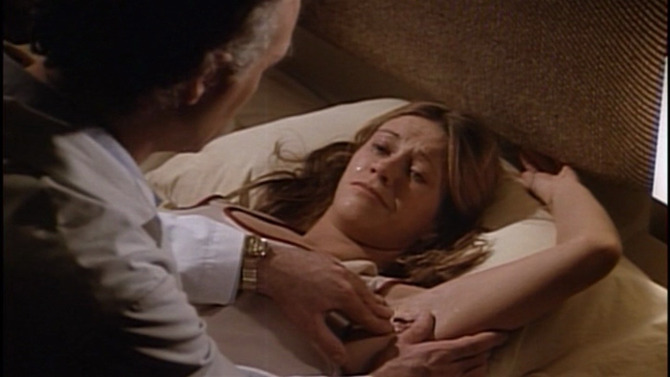Only David Cronenberg’s second feature film (which he both writes and directs), 1977’s Rabid continues his precedence for a very unique form of horror, often referred to as ‘body horror’. . . a study in human beings, their fears, apprehensions, an awkwardness revolving around their own (and others’) bodies.
Set in and around one of the most unique cities in North America – Montreal, the genesis event finds a couple, Rose (pornstar Marilyn Chambers) and Hart (Frank Moore), getting in a horrific motorcycle accident in the country. Though Hart is beat up, it is Rose that is truly in rough shape. Stranded in a most unpopulated place, they are fortunate that the exclusive Dr. Keloid Clinic for Plastic Surgery (a sort of touch up resort) is nearby. . . taking the severely injured woman in for immediate surgery.
Dr. Keloid (Howard Ryshpan) saves her life by attempting a radical form of experimental surgery on the young woman (using a unique form of grafts, his hopes are that it will regenerate her damaged organs and skin), though, in the process, she falls into a coma. Hart, truly in love, returns home a month later (recovered himself), though that does not stop his mind from lingering on his beloved.
Late one night, the comatose patient arises, though, in reality, something has happened, for Rose is no longer the wholesome girl-next-door she once was. . . for one of her wounds (found in the region of her right armpit) has morphed into something different. In the shape of a slit resembling female genitalia, hidden within is something wholly disturbing – an almost tentacle-like pincer that is not there for show. Like a living vampire, it sucks the blood from unsuspecting victims. . . the sustenance she now needs to survive.
Intriguingly, Rose is not fully gone. She is still a thinking, kind being, in love with Hart and truly caring for her longtime best friend, Mindy (Susan Roman). Not fully understanding of her condition, her former self still echoes within, yearning for things like food, kinship and freedom. Yet, her body is at odds with itself, her memories and human habits waning as the bloodsucking new organ continues to slake its primordial desire.
Further complicating things, this hidden appendage infects those it drinks from, some sort of zombie-like rabies transforming human beings into mindless biters (in just six or so hours – a very fast gestation period). Having escaped the confines of the clinic, can anything stop Rose, and, in turn, the plague she is spreading?
With an intoxicating visual presence, Rabid feeds off of its Montreal setting. We watch as Rose takes a walk (in a fluffy fur coat) along the flashing streets one night, a mesmerizing sequence that finds her meandering through the sex district of the city, symbolic of her own hungry desires (she enters an adult movie theatre in hope, not of finding something engorged, but rather, to gorge). Lighting her striking cheekbones, it is not only the on set locations that impress. Understanding his visuals, this palpable atmosphere is combined with Cronenberg’s now iconic sense of finding horror in the human body. Yet, beyond that, Rabid can be read in numerous ways. Is it an analysis of women’s power over men? – as soon as her pincer strikes, men go insane. . . or perhaps more accurately, the control female genitalia can have over the opposite sex. Is it a look at the infamous FLQ Crisis (where near martial law was imposed in Canada in 1970)? – for we see this in the narrative as police control the nighttime streets, using garbage trucks and sniper rifles to dispose of the growing hordes. Perhaps it is a warning of how plastic surgery can change you. . . transforming someone into a wholly different person – is anyone even sure that that is truly Kenny Rogers?
Yet, at its heart, it is a strong, female led story. Chambers, perhaps surprisingly, does a more than solid job bringing this sympathetic character to life. Not at all her fault, she awakens with an uncontrollable burden, needing to feed to survive, yet, she still wants the things she once had. . . a loving boyfriend, a good meal, and a normal life. As she goes on her journey, you have to wonder if she will ever recapture what she once had, or if things are predestined to end tragically.
To return to Chambers once more, Cronenberg’s original choice was Sissy Spacek (who, while Rabid was in production, went on to stardom when Carrie was released – you can actually spot the film’s poster during her night walk through the lively district), yet the film making team ended up deciding that her Texan accent was too strong. In the end, producer Ivan Reitman spotted Chambers doing an interview, and was impressed by her smarts and looks. . . passing on the information to Cronenberg, they reached out to her, and the rest is history. In a way playing against type, she only appears nude in two brief scenes, instead bringing forward her wholesome and innocent look to create a surprisingly dichotomous figure that combines an innocent young woman with a constantly stalking predator.
A rare Canadian film that made money (especially during this era), Rabid still packs quite the armpit bite. Both dramatic and horrific, tragic and gruesome, it finds a happy medium between story and scares. So, don’t be a pussy, take the time to make a procedure out of watching this flick, it doesn’t deserve to be in the trash.



